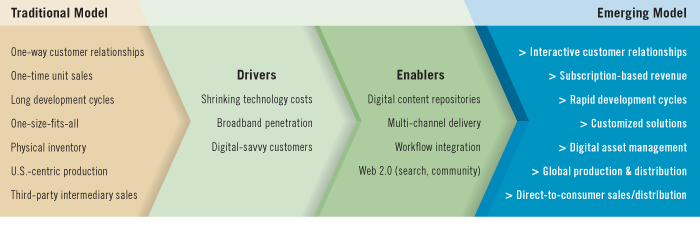
How Technology is Changing the Marketplace and Driving Long-Term Global Growth
Connecting content and managing digital assets globally across all of The McGraw-Hill Companies is an essential part of the effort to grow revenue, reduce costs, and improve workflow and productivity. Technology investments support MHP’s ability to provide its customers with products and services that represent the shift to an emerging model. For MHP, technology represents a tremendous opportunity in serving the business-to-business and business-to-consumer communities–an opportunity to enhance its offerings, embed its solutions into customers’ workflow and infrastructure, and build stronger, broader relationships that add more value.
Leveraging the Emerging Model in MHP's Key Markets
The emerging model is enabling MHP’s three segments—Education, Financial Services and Information & Media—to maintain leadership positions in their respective fields, serving the enduring global needs for knowledge, capital, and information transparency. As a result, MHP is well situated for the future.
| Education | Financial | Information | |||
| Politicians and corporate leaders around the world increasingly understand that an educated population is essential for competitiveness. | Global financial markets are still far from fully recovered from the financial crisis. Nevertheless, raising capital is an essential part of any market economy, and companies, individuals, and governments will still have a need to borrow for the foreseeable future. |
An increasingly information-driven global economy will create new opportunities for information providers such as McGraw-Hill. McGraw-Hill delivers critical information to the energy, construction, aerospace and defense, automotive, and general business markets. | |||
| Short Term: | Short Term: | Short Term: | |||
| Federal financial support for education is continuing to stay strong, easing the impact of budget cutbacks at the local and state levels. | The gradual easing of the financial crisis will promote more of a return to normal credit markets and normal patterns of debt. Global debt underwriting in the first quarter of 2009 rose by 23% over a year earlier. | A volatile economy, with its sudden shifts and swerves, boosts the demand for useful information—in many formats and frequencies. | |||
| Long Term: | Long Term: | Long Term: | |||
| Enrollments
at all levels are expected to rise by 9% over the next decade, propelling spending upwards. |
As
the global economy continues to expand, the global capital markets will grow along with it. |
The role of manufacturing in global trade is likely to shrink over time. In its place, the production and distribution of information and other intangibles is going to become more important. | |||
